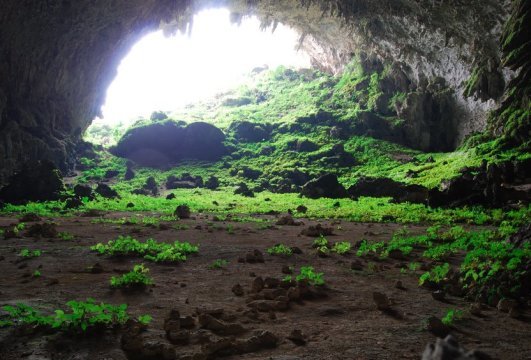Royal Botanic Gardens Kew
Summary:
Over five years (2009-2014) researchers have delved into the depths of some of China's most unexplored and unknown caves in the largest ever study on cave floras. Surveying over 60 caves in the Guangxi, Guizhou and Yunnan regions, they were able to assess the vascular plant diversity of cave flora in more detail than ever before.

Yangzi cave, Guangxi, China. The cave entrance is approximately 70 m wide, 15 m high and the depth of the entrance cavern supporting vascular plants 170 m. This cave is type locality for 8 vascular plant species.
Credit: Monro et al. Discovery of a diverse cave flora in China. PLOS ONE, 2018; DOI: 10.1371/journal.pone.0190801
Exciting new data on cave flora has been published today in PLOS ONE in a paper by researchers from the Royal Botanic Gardens, Kew and the Guangxi Institute of Botany in China.
Over five years (2009-2014) the researchers delved into the depths of some of China's most unexplored and unknown caves in the largest ever study on cave floras. Surveying over 60 caves in the Guangxi, Guizhou and Yunnan regions, Kew's Alex Monro and his colleagues from Guangxi were able to assess the vascular plant diversity of cave flora in more detail than ever before.
From the 1950's to the 1970's, forests in SW China was virtually wiped out due to the demand for charcoal associated with rapid industrialisation during China's Great Leap Forward and the Cultural Revolution. This study documents 31 species known only from caves, leading the team to speculate that cave populations are all that remain of species which once grew in the 'understory' (the layer of vegetation between the forest canopy and the ground), which has been wiped out by recent deforestation. This discovery makes these caves and their flora significant and valuable for species conservation in South West China.
Lead researcher Alexandre Monro, at Royal Botanic Gardens, Kew says; "This collaboration with the Guangxi institute of Botany in China is a first attempt to document the presence of vascular plants in caves in Southeast Asia. Before we started we had no idea of the diversity of plants in caves, or that so many species are known only from caves. We hope that this work will lead to a greater interest in caves amongst botanists, and also to a greater interest in plants amongst cave biologists, prompting more study of cave-rich landscapes in Southeast Asia."
Over the course of the study, 418 species of vascular plants were recorded, with 7% of these species being endemic to caves and 37% of the species endemic to China. Once all caves have been samples in the region, the real figure is likely to be between 500 and 850 species, based on modelling conducted by this team.
The other conclusion of the study is that the twilight zones in caves can be considered distinct biomes for plants based on a combination of constant and aseasonal climate, as well as very low light. The authors document plants growing in some of the lowest light levels recorded for vascular plants, suggesting a broad range of plants can photosynthesise at much lower light levels than originally thought.
Whilst exploring the entrance caverns, the team observed that almost half of the caves sampled were impacted by tourism or agriculture, with tourism being the more frequent and impactful.
Story Source:
Materials provided by Royal Botanic Gardens Kew.
Hi! I am a robot. I just upvoted you! I found similar content that readers might be interested in:
https://sciencesources.eurekalert.org/pub_releases/2018-02/rbgk-nrr020718.php
Downvoting a post can decrease pending rewards and make it less visible. Common reasons:
Submit
What it looks like walking out to get the paper on the morning of the apocalypse...
Downvoting a post can decrease pending rewards and make it less visible. Common reasons:
Submit